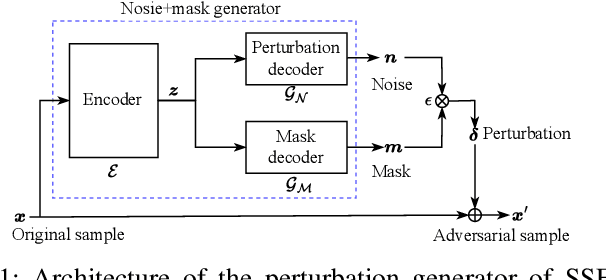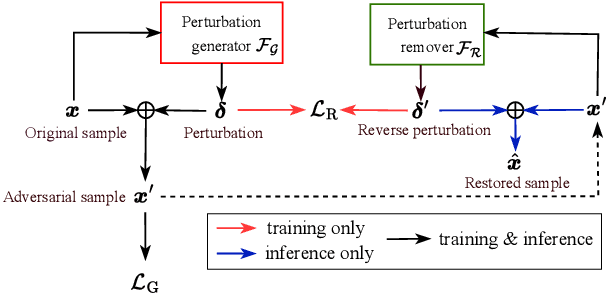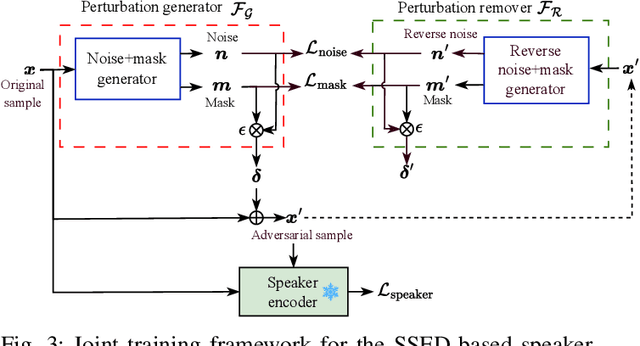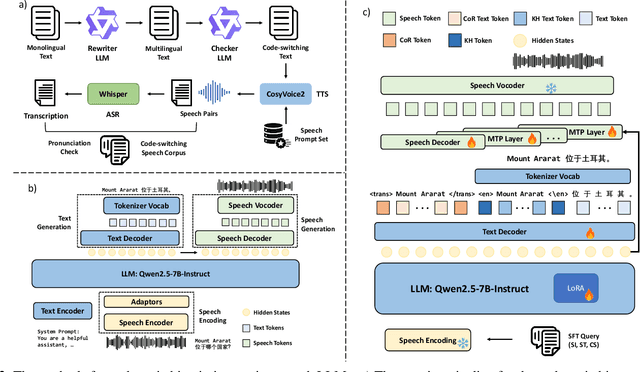speech recognition
Speech recognition is the task of identifying words spoken aloud, analyzing the voice and language, and accurately transcribing the words.
Papers and Code
Evaluating Self-Supervised Speech Models via Text-Based LLMS
Oct 06, 2025Self-Supervised Learning (SSL) has gained traction for its ability to learn rich representations with low labeling costs, applicable across diverse downstream tasks. However, assessing the downstream-task performance remains challenging due to the cost of extra training and evaluation. Existing methods for task-agnostic evaluation also require extra training or hyperparameter tuning. We propose a novel evaluation metric using large language models (LLMs). By inputting discrete token sequences and minimal domain cues derived from SSL models into LLMs, we obtain the mean log-likelihood; these cues guide in-context learning, rendering the score more reliable without extra training or hyperparameter tuning. Experimental results show a correlation between LLM-based scores and automatic speech recognition task. Additionally, our findings reveal that LLMs not only functions as an SSL evaluation tools but also provides inference-time embeddings that are useful for speaker verification task.
EvolveCaptions: Empowering DHH Users Through Real-Time Collaborative Captioning
Oct 02, 2025Automatic Speech Recognition (ASR) systems often fail to accurately transcribe speech from Deaf and Hard of Hearing (DHH) individuals, especially during real-time conversations. Existing personalization approaches typically require extensive pre-recorded data and place the burden of adaptation on the DHH speaker. We present EvolveCaptions, a real-time, collaborative ASR adaptation system that supports in-situ personalization with minimal effort. Hearing participants correct ASR errors during live conversations. Based on these corrections, the system generates short, phonetically targeted prompts for the DHH speaker to record, which are then used to fine-tune the ASR model. In a study with 12 DHH and six hearing participants, EvolveCaptions reduced Word Error Rate (WER) across all DHH users within one hour of use, using only five minutes of recording time on average. Participants described the system as intuitive, low-effort, and well-integrated into communication. These findings demonstrate the promise of collaborative, real-time ASR adaptation for more equitable communication.
A Study of the Removability of Speaker-Adversarial Perturbations
Oct 10, 2025



Recent advancements in adversarial attacks have demonstrated their effectiveness in misleading speaker recognition models, making wrong predictions about speaker identities. On the other hand, defense techniques against speaker-adversarial attacks focus on reducing the effects of speaker-adversarial perturbations on speaker attribute extraction. These techniques do not seek to fully remove the perturbations and restore the original speech. To this end, this paper studies the removability of speaker-adversarial perturbations. Specifically, the investigation is conducted assuming various degrees of awareness of the perturbation generator across three scenarios: ignorant, semi-informed, and well-informed. Besides, we consider both the optimization-based and feedforward perturbation generation methods. Experiments conducted on the LibriSpeech dataset demonstrated that: 1) in the ignorant scenario, speaker-adversarial perturbations cannot be eliminated, although their impact on speaker attribute extraction is reduced, 2) in the semi-informed scenario, the speaker-adversarial perturbations cannot be fully removed, while those generated by the feedforward model can be considerably reduced, and 3) in the well-informed scenario, speaker-adversarial perturbations are nearly eliminated, allowing for the restoration of the original speech. Audio samples can be found in https://voiceprivacy.github.io/Perturbation-Generation-Removal/.
CS3-Bench: Evaluating and Enhancing Speech-to-Speech LLMs for Mandarin-English Code-Switching
Oct 09, 2025



The advancement of multimodal large language models has accelerated the development of speech-to-speech interaction systems. While natural monolingual interaction has been achieved, we find existing models exhibit deficiencies in language alignment. In our proposed Code-Switching Speech-to-Speech Benchmark (CS3-Bench), experiments on 7 mainstream models demonstrate a relative performance drop of up to 66% in knowledge-intensive question answering and varying degrees of misunderstanding in open-ended conversations. Starting from a model with severe performance deterioration, we propose both data constructions and training approaches to improve the language alignment capabilities, specifically employing Chain of Recognition (CoR) to enhance understanding and Keyword Highlighting (KH) to guide generation. Our approach improves the knowledge accuracy from 25.14% to 46.13%, with open-ended understanding rate from 64.5% to 86.5%, and significantly reduces pronunciation errors in the secondary language. CS3-Bench is available at https://huggingface.co/datasets/VocalNet/CS3-Bench.
Decoding Deception: Understanding Automatic Speech Recognition Vulnerabilities in Evasion and Poisoning Attacks
Sep 26, 2025Recent studies have demonstrated the vulnerability of Automatic Speech Recognition systems to adversarial examples, which can deceive these systems into misinterpreting input speech commands. While previous research has primarily focused on white-box attacks with constrained optimizations, and transferability based black-box attacks against commercial Automatic Speech Recognition devices, this paper explores cost efficient white-box attack and non transferability black-box adversarial attacks on Automatic Speech Recognition systems, drawing insights from approaches such as Fast Gradient Sign Method and Zeroth-Order Optimization. Further, the novelty of the paper includes how poisoning attack can degrade the performances of state-of-the-art models leading to misinterpretation of audio signals. Through experimentation and analysis, we illustrate how hybrid models can generate subtle yet impactful adversarial examples with very little perturbation having Signal Noise Ratio of 35dB that can be generated within a minute. These vulnerabilities of state-of-the-art open source model have practical security implications, and emphasize the need for adversarial security.
A Parallel Ultra-Low Power Silent Speech Interface based on a Wearable, Fully-dry EMG Neckband
Sep 26, 2025



We present a wearable, fully-dry, and ultra-low power EMG system for silent speech recognition, integrated into a textile neckband to enable comfortable, non-intrusive use. The system features 14 fully-differential EMG channels and is based on the BioGAP-Ultra platform for ultra-low power (22 mW) biosignal acquisition and wireless transmission. We evaluate its performance on eight speech commands under both vocalized and silent articulation, achieving average classification accuracies of 87$\pm$3% and 68$\pm$3% respectively, with a 5-fold CV approach. To mimic everyday-life conditions, we introduce session-to-session variability by repositioning the neckband between sessions, achieving leave-one-session-out accuracies of 64$\pm$18% and 54$\pm$7% for the vocalized and silent experiments, respectively. These results highlight the robustness of the proposed approach and the promise of energy-efficient silent-speech decoding.
Interpreting the Role of Visemes in Audio-Visual Speech Recognition
Sep 19, 2025Audio-Visual Speech Recognition (AVSR) models have surpassed their audio-only counterparts in terms of performance. However, the interpretability of AVSR systems, particularly the role of the visual modality, remains under-explored. In this paper, we apply several interpretability techniques to examine how visemes are encoded in AV-HuBERT a state-of-the-art AVSR model. First, we use t-distributed Stochastic Neighbour Embedding (t-SNE) to visualize learned features, revealing natural clustering driven by visual cues, which is further refined by the presence of audio. Then, we employ probing to show how audio contributes to refining feature representations, particularly for visemes that are visually ambiguous or under-represented. Our findings shed light on the interplay between modalities in AVSR and could point to new strategies for leveraging visual information to improve AVSR performance.
State-of-the-Art Dysarthric Speech Recognition with MetaICL for on-the-fly Personalization
Sep 19, 2025Personalizing Automatic Speech Recognition (ASR) for dysarthric speech is crucial but challenging due to training and storing of individual user adapters. We propose a hybrid meta-training method for a single model, excelling in zero-shot and few-shot on-the-fly personalization via in-context learning (ICL). Measuring Word Error Rate (WER) on state-of-the-art subsets, the model achieves 13.9% WER on Euphonia which surpasses speaker-independent baselines (17.5% WER) and rivals user-specific personalized models. On SAP Test 1, its 5.3% WER significantly bests the 8% from even personalized adapters. We also demonstrate the importance of example curation, where an oracle text-similarity method shows 5 curated examples can achieve performance similar to 19 randomly selected ones, highlighting a key area for future efficiency gains. Finally, we conduct data ablations to measure the data efficiency of this approach. This work presents a practical, scalable, and personalized solution.
UMA-Split: unimodal aggregation for both English and Mandarin non-autoregressive speech recognition
Sep 18, 2025This paper proposes a unimodal aggregation (UMA) based nonautoregressive model for both English and Mandarin speech recognition. The original UMA explicitly segments and aggregates acoustic frames (with unimodal weights that first monotonically increase and then decrease) of the same text token to learn better representations than regular connectionist temporal classification (CTC). However, it only works well in Mandarin. It struggles with other languages, such as English, for which a single syllable may be tokenized into multiple fine-grained tokens, or a token spans fewer than 3 acoustic frames and fails to form unimodal weights. To address this problem, we propose allowing each UMA-aggregated frame map to multiple tokens, via a simple split module that generates two tokens from each aggregated frame before computing the CTC loss.
Thinking in cocktail party: Chain-of-Thought and reinforcement learning for target speaker automatic speech recognition
Sep 19, 2025Target Speaker Automatic Speech Recognition (TS-ASR) aims to transcribe the speech of a specified target speaker from multi-speaker mixtures in cocktail party scenarios. Recent advancement of Large Audio-Language Models (LALMs) has already brought some new insights to TS-ASR. However, significant room for optimization remains for the TS-ASR task within the LALMs architecture. While Chain of Thoughts (CoT) and Reinforcement Learning (RL) have proven effective in certain speech tasks, TS-ASR, which requires the model to deeply comprehend speech signals, differentiate various speakers, and handle overlapping utterances is particularly well-suited to a reasoning-guided approach. Therefore, we propose a novel framework that incorporates CoT and RL training into TS-ASR for performance improvement. A novel CoT dataset of TS-ASR is constructed, and the TS-ASR model is first trained on regular data and then fine-tuned on CoT data. Finally, the model is further trained with RL using selected data to enhance generalized reasoning capabilities. Experiment results demonstrate a significant improvement of TS-ASR performance with CoT and RL training, establishing a state-of-the-art performance compared with previous works of TS-ASR on comparable datasets.
 Add to Chrome
Add to Chrome Add to Firefox
Add to Firefox Add to Edge
Add to Edge